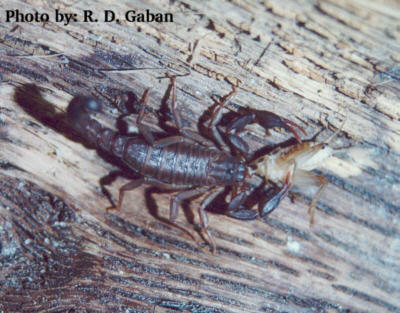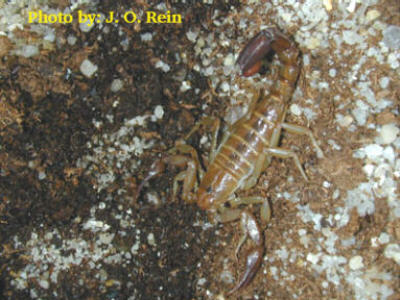
Look HERE to see some characters of MOST species of Vaejovis. Note the pentagonal sternum (where the legs come together), and the spines that terminate the keels of the metasoma (tail).
Genus Vaejovis Koch, 1836
eusthenura group
* Vaejovis confusus Stahnke, 1940
Vaejovis flavus Banks, 1901
Vaejovis puritanus Gertsch, 1958
Vaejovis waeringi Williams, 1970
* Vaejovis
coahuilae Williams, 1968
* Vaejovis
globosus Borelli, 1915
* Vaejovis
spinigerus (Wood, 1863)
* Vaejovis
waueri Gertsch & Soleglad, 1972
Vaejovis
carolinianus (Beauvois, 1821)
Distribution: Southern Appalachian Mountains and foothills of the
Southeastern United States. Alabama, Georgia, Kentucky, North Carolina,
South Carolina, Tennessee, Virginia.
Vaejovis chisos Sissom, 1990
Vaejovis jonesi Stahnke, 1940
* Vaejovis lapidicola Stahnke 1940
* Vaejovis paysonensis Soleglad, 1973
Vaejovis
vorhiesi Stahnke, 1940
Additional undescribed species occur in the forested mountains of * Arizona and * New
Mexico.
nitidulus group
* Vaejovis
intermedius Borelli, 1912
spicatus group
These little vaejovids have fat hands, are yellowish, and have a large subaculear spine on the telson.
Vaejovis mumai Sissom, 1993
Vaejovis spicatus Haradon, 1974
punctipalpi group
These species do not have "spines" on the metasoma (tail) segments, making the metasoma (only) similar in appearance to Centruroides, Paruroctonus, and Smeringurus.
* Vaejovis
crassimanus Pocock, 1898
* Vaejovis hirsuticauda Banks, 1910
* Vaejovis
russelli Williams, 1971
Vaejovis species
ScorpionHome
Photo of adult male from Maricopa County, Arizona, specimen courtesy Chad Lee.
Distribution: In the Sonoran Desert, sands to rocky areas. Arizona:
* Graham, * Maricopa, * Pima, Gila, and Pinal counties (other localities not yet
published). California, Idaho, Nevada, * Utah. Also northern
Mexico.
Note: Vaejovis confusus may actually turn out to be a tightly-knit
species complex of three or more species (Bigelow, pers. comm., 1994).
Here is an Undescribed species from Fresno County, California. (Thanks Dave Gaban!)
Distribution: New Mexico: Albuquerque, Bernalillo County.
Note: Type locality is "Albuquerque, New Mexico," based on a single female
specimen. To this date, the type female is the only known specimen referable to
Vaejovis flavus.
Distribution: California: Chaparral and coastal mountains of southwestern
California in Riverside, San Bernardino, and San Diego counties. Also Baja
California Mexico. Type localities: Santo Tomas, Baja California Norte,
Mexico, and Jacumba, San Diego County, California.
Note: Vaejovis schwenkmeyeri Williams (type locality Bahia de los
Angeles, Baja California, Mexico) and V. terradomus
Williams (type locality Rancho Canipole, Baja California Sur) are junior
synonyms.
This and the above several species look superficially like Vaejovis confusus, one needs a microscope fitted with a micrometer to ensure identification in most cases. Usually, measurement ratios involving finger length and other lengths are the key.
Distribution: California: Colorado and Mojave deserts of southern California
in Imperial and San Bernardino counties. Also Baja California, Mexico
(type locality Oakie’s Landing).
Note: Vaejovis coloradensis Williams (type locality Andrade,
Imperial County, CA) is a junior synonym. Vaejovis waeringi
is easily confused with its eastern relative, Vaejovis
confusus.
Photo of adult female from Loving County, Texas, specimen courtesy W. David Sissom.
V. coahuilae from New Mexico, courtesy and Copyright 1999 R. David Gaban.
Distribution: Common inhabitant of the Chihuahuan Desert and associated
grasslands and mountains. Arizona: * Cochise County; throughout much
of * New Mexico (specific localities yet to be published); Western
Texas from the * Panhandle to near Val Verde County and westward into
Mexico and New Mexico (Jackman, 1997). Also in Coahuila (type
locality Cuatro Cienegas), Mexico, doubtless Chihuahua.
Distribution: Soft sandy soils of the Chihuahuan Desert. Texas:
Brewster and * Presidio counties, in silty sands along the Rio Grande. Also in
Durango (type locality Dinamita), Coahuila, and Zacatecas, Mexico.
Note: Vaejovis gilvus Williams (type locality Cuatro Cienegas,
Coahuila, Mexico) is a junior synonym.
Photo of Male and Female from Maricopa County, Arizona, specimens courtesy Chad Lee.
Distribution: Sonoran Desert and associated chaparral, grasslands, and
mountains, roughly the same distribution as the saguaro cactus. Arizona:
* Cochise, * Greenlee, * Maricopa, * Yavapai, * Gila, * Santa Cruz, * Graham, Pinal, and * Pima
counties. * New Mexico: along border with Arizona (specific localities not
yet published). Extreme southeastern California. Also in Sonora,
Mexico.
Note: Not reported from its type locality of “Texas” since 1863.
Possibly a species complex representing several species (Bigelow, 1994; Sissom, 2000).
Additional photos:Ventral view of female; Ventral view of male (both Chad's). Note the shape of the pectines (combs) and you will see the gender difference in nearly all scorpion species.
Dorsal view of a different male.
A 70 mm female from near Four Peaks, Maricopa County, Arizona, 2007.
Photo of adult female V. waueri courtesy of and Copyright 1999 R. David Gaban. Scroll the image down to note the comparative size of the penny!
Distribution: Rocky areas in the Chihuahuan Desert of Texas and
Mexico (Hendrixson, 2001), and along the Rio Grande to as far south
as * Zapata, Texas. Texas: Brewster (type locality Chisos Basin,
Big Bend National Park), * Crockett, Crosby, Garza, Jeff Davis, * Kinney, * Maverick,
Pecos, * Terrell, * Starr, Webb, and * Tom Green. Mexico: * Chihuahua,
Nuevo Leon.
Note: The specimens reported in the original description from near Alamos,
Sonora, Mexico now represent a new species, Vaejovis pequeno Hendrixson, 2001.
 mexicanus group Soleglad, 1973
mexicanus group Soleglad, 1973
Photo at right of female V. carolinianus, courtesy of and Copyright 1999 R. David Gaban.
Note: Old Texas records of Vaejovis carolinianus and
Vaejovis mexicanus are referable to Pseudouroctonus reddelli.
Distribution: Texas: Chisos Mountains, Big Bend National Park, Brewster
County.
Note: Only three specimens known, even though several return trips to the
known localities produced no additional specimens. Adult male unknown.
Distribution: Colorado Plateau/Monument Valley in mountains and desert.
Northern Arizona (type locality is Flagstaff) and southern Utah
(specific localities unpublished). Possibly western New Mexico and southwestern
Colorado.
Distribution: Arizona: * Coconino County, Flagstaff and vicinity (additional
records unpublished; Bigelow).
Distribution: Pine forests along the Mogollon Rim in Arizona west and southwest of Showlow. Type
locality is along the * Mogollon Rim near Payson, Gila County.
Photo of preserved female compared to dime for size.
Distribution: Arizona: Santa Cruz and Cochise counties, in Huachuca and
Santa Rita mountains.

Photo at right of female V. intermedius, courtesy of and Copyright 1999 Jan Ove Rein.
Distribution: Rocky areas, mountains, canyons, and rocky roadcuts in the
Chihuahuan Desert Region of Trans-Pecos Texas to Dinamita (type
locality), Durango, Mexico (type locality): Texas: * Terrell,
* Brewster, Crockett, * Presidio, * Val Verde counties. Also in Mexico:
* Chihuahua, Durango.
One of my all-time favorite species! Very quick, large, and apt to sting!
Distribution: Arizona: Gold Road and Parker (type locality is “P” Mountain),
Mohave County.
Note: Presumably very rare on rocky slopes.
Distribution: California: Berdoo Canyon, Little San Bernardino Mountains
(type locality), and Pleasant Valley, Joshua Tree National Monument, Riverside
County.
Note: Presumably very rare on rocky slopes.
Preserved adult male V. crassimanus from Big Bend Ranch State Park, TX. Photo (c) 2001 Kari J. McWest.
Distribution: Creosote/desert scrub communities in the Chihuahuan Desert.
Arizona: near Portal, Cochise County. * New Mexico:
Chihuahuan Desert (specific localities unpublished; Sissom). * Texas:
Chihuahuan Desert counties of western Texas, extending along the * Rio Grande
south to near Zapata. Also in Mexico (unpublished localities).
Note: Not known from San Diego, Texas, the type locality (as with
Vaejovis bilineatus, San Diego may be only the mailing origin
and not a collecting locality: V. bilineatus is not known from
Texas, but is found southwest of Texas in Mexico).
Distribution: Wide-ranging and common in the western US deserts into Baja
California. Arizona (western border with Utah and Nevada), southern
California (type, “San Bernardino County”), and southern
Nevada (possibly widespread) and * Utah (possibly widespread).
Baja California, Mexico. Photo of preserved female from Kofa Mtns, Yuma County, Arizona (Joe Bigelow), copyright 2001 Kari J McWest.
Photo of living female courtesy of and Copyright Graeme Lowe.
Distribution: Widespread, but not very common, in the northern Chihuahuan
Desert and associated mountains and grasslands. Arizona: eastern
Cochise County (type * Portal). * New Mexico: widespread (specific
localities unpublished: Sissom). * Texas: Culberson, Jeff Davis, and
Brewster counties north and west into the * Panhandle (Jackman, 1997). Doubtless occurs in
Chihuahua, Mexico.Photo of adult female from Randall County, Texas, copyright 2001 Kari J McWest.
Photo of living male (note massive hands) by Mein;
Photo of living female, posterior view, showing lack of stripes and darkened fifth segment (as in Vaejovis
crassimanus, which can be found together in parts of their distributions), specimen courtesy W.D. Sissom.
Note: A punctipalpi group species has recently been found near
Tucson, Arizona. Its identity is still being investigated by Joe Bigelow
and David Sissom.
Paruroctonus/Smeringurus Checklist
Non-Vaejovis Vaejovidae Checklist
Non-Vaejovidae
Checklist